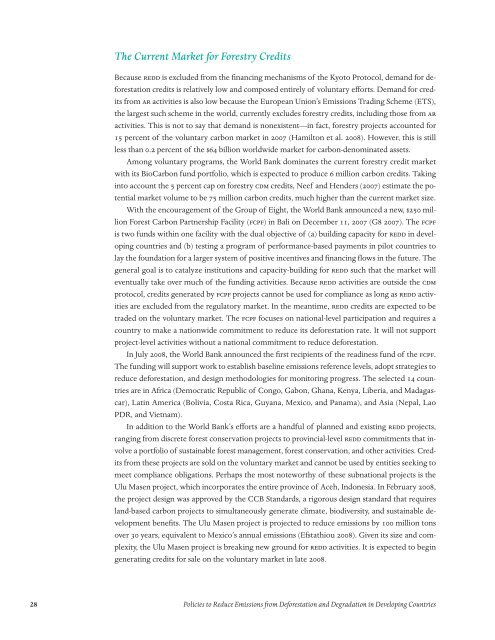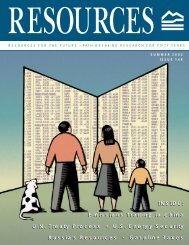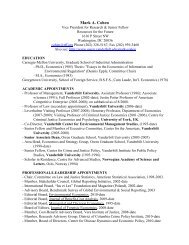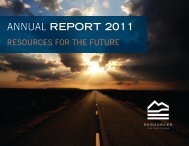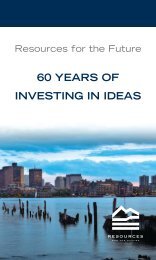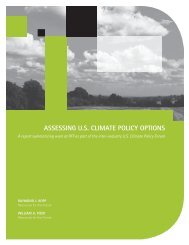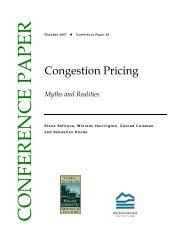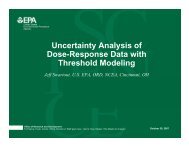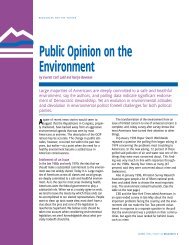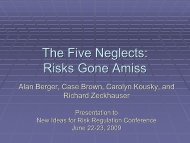Policies to Reduce Emissions from Deforestation and Degradation ...
Policies to Reduce Emissions from Deforestation and Degradation ...
Policies to Reduce Emissions from Deforestation and Degradation ...
You also want an ePaper? Increase the reach of your titles
YUMPU automatically turns print PDFs into web optimized ePapers that Google loves.
The Current Market for Forestry Credits<br />
Because REDD is excluded <strong>from</strong> the financing mechanisms of the Kyo<strong>to</strong> Pro<strong>to</strong>col, dem<strong>and</strong> for deforestation<br />
credits is relatively low <strong>and</strong> composed entirely of voluntary efforts. Dem<strong>and</strong> for credits<br />
<strong>from</strong> AR activities is also low because the European Union’s <strong>Emissions</strong> Trading Scheme (ETS),<br />
the largest such scheme in the world, currently excludes forestry credits, including those <strong>from</strong> AR<br />
activities. This is not <strong>to</strong> say that dem<strong>and</strong> is nonexistent—in fact, forestry projects accounted for<br />
15 percent of the voluntary carbon market in 2007 (Hamil<strong>to</strong>n et al. 2008). However, this is still<br />
less than 0.2 percent of the $64 billion worldwide market for carbon-denominated assets.<br />
Among voluntary programs, the World Bank dominates the current forestry credit market<br />
with its BioCarbon fund portfolio, which is expected <strong>to</strong> produce 6 million carbon credits. Taking<br />
in<strong>to</strong> account the 5 percent cap on forestry CDM credits, Neef <strong>and</strong> Henders (2007) estimate the potential<br />
market volume <strong>to</strong> be 75 million carbon credits, much higher than the current market size.<br />
With the encouragement of the Group of Eight, the World Bank announced a new, $250 million<br />
Forest Carbon Partnership Facility (FCPF) in Bali on December 11, 2007 (G8 2007). The FCPF<br />
is two funds within one facility with the dual objective of (a) building capacity for REDD in developing<br />
countries <strong>and</strong> (b) testing a program of performance-based payments in pilot countries <strong>to</strong><br />
lay the foundation for a larger system of positive incentives <strong>and</strong> financing flows in the future. The<br />
general goal is <strong>to</strong> catalyze institutions <strong>and</strong> capacity-building for REDD such that the market will<br />
eventually take over much of the funding activities. Because REDD activities are outside the CDM<br />
pro<strong>to</strong>col, credits generated by FCPF projects cannot be used for compliance as long as REDD activities<br />
are excluded <strong>from</strong> the regula<strong>to</strong>ry market. In the meantime, REDD credits are expected <strong>to</strong> be<br />
traded on the voluntary market. The FCPF focuses on national-level participation <strong>and</strong> requires a<br />
country <strong>to</strong> make a nationwide commitment <strong>to</strong> reduce its deforestation rate. It will not support<br />
project-level activities without a national commitment <strong>to</strong> reduce deforestation.<br />
In July 2008, the World Bank announced the first recipients of the readiness fund of the FCPF.<br />
The funding will support work <strong>to</strong> establish baseline emissions reference levels, adopt strategies <strong>to</strong><br />
reduce deforestation, <strong>and</strong> design methodologies for moni<strong>to</strong>ring progress. The selected 14 countries<br />
are in Africa (Democratic Republic of Congo, Gabon, Ghana, Kenya, Liberia, <strong>and</strong> Madagascar),<br />
Latin America (Bolivia, Costa Rica, Guyana, Mexico, <strong>and</strong> Panama), <strong>and</strong> Asia (Nepal, Lao<br />
PDR, <strong>and</strong> Vietnam).<br />
In addition <strong>to</strong> the World Bank’s efforts are a h<strong>and</strong>ful of planned <strong>and</strong> existing REDD projects,<br />
ranging <strong>from</strong> discrete forest conservation projects <strong>to</strong> provincial-level REDD commitments that involve<br />
a portfolio of sustainable forest management, forest conservation, <strong>and</strong> other activities. Credits<br />
<strong>from</strong> these projects are sold on the voluntary market <strong>and</strong> cannot be used by entities seeking <strong>to</strong><br />
meet compliance obligations. Perhaps the most noteworthy of these subnational projects is the<br />
Ulu Masen project, which incorporates the entire province of Aceh, Indonesia. In February 2008,<br />
the project design was approved by the CCB St<strong>and</strong>ards, a rigorous design st<strong>and</strong>ard that requires<br />
l<strong>and</strong>-based carbon projects <strong>to</strong> simultaneously generate climate, biodiversity, <strong>and</strong> sustainable development<br />
benefits. The Ulu Masen project is projected <strong>to</strong> reduce emissions by 100 million <strong>to</strong>ns<br />
over 30 years, equivalent <strong>to</strong> Mexico’s annual emissions (Efstathiou 2008). Given its size <strong>and</strong> complexity,<br />
the Ulu Masen project is breaking new ground for REDD activities. It is expected <strong>to</strong> begin<br />
generating credits for sale on the voluntary market in late 2008.<br />
2 <strong>Policies</strong> <strong>to</strong> <strong>Reduce</strong> <strong>Emissions</strong> <strong>from</strong> <strong>Deforestation</strong> <strong>and</strong> <strong>Degradation</strong> in Developing Countries


